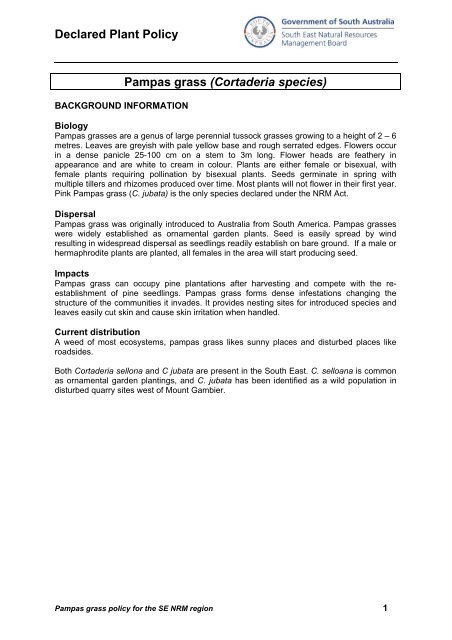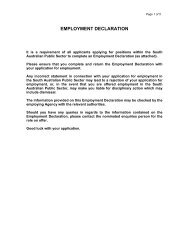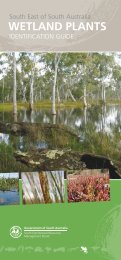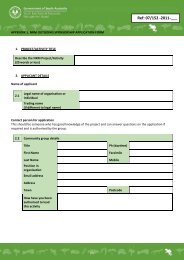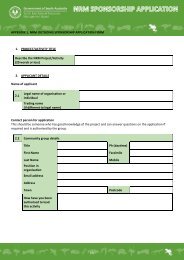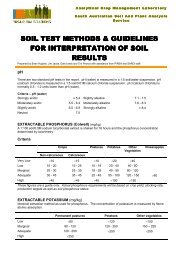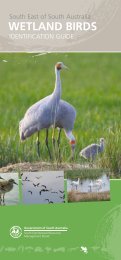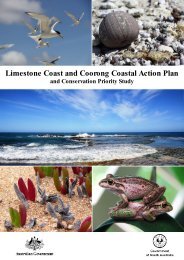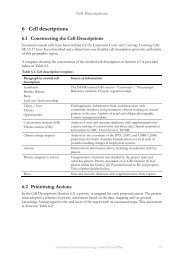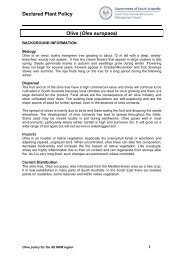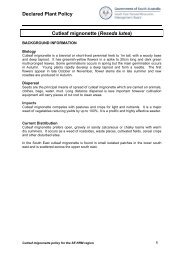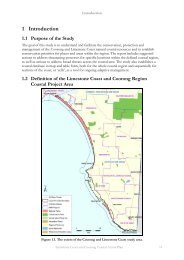Pampas grass policy - South East Natural Resources Management ...
Pampas grass policy - South East Natural Resources Management ...
Pampas grass policy - South East Natural Resources Management ...
You also want an ePaper? Increase the reach of your titles
YUMPU automatically turns print PDFs into web optimized ePapers that Google loves.
Declared Plant Policy<br />
BACKGROUND INFORMATION<br />
<strong>Pampas</strong> <strong>grass</strong> (Cortaderia species)<br />
Biology<br />
<strong>Pampas</strong> <strong>grass</strong>es are a genus of large perennial tussock <strong>grass</strong>es growing to a height of 2 – 6<br />
metres. Leaves are greyish with pale yellow base and rough serrated edges. Flowers occur<br />
in a dense panicle 25-100 cm on a stem to 3m long. Flower heads are feathery in<br />
appearance and are white to cream in colour. Plants are either female or bisexual, with<br />
female plants requiring pollination by bisexual plants. Seeds germinate in spring with<br />
multiple tillers and rhizomes produced over time. Most plants will not flower in their first year.<br />
Pink <strong>Pampas</strong> <strong>grass</strong> (C. jubata) is the only species declared under the NRM Act.<br />
Dispersal<br />
<strong>Pampas</strong> <strong>grass</strong> was originally introduced to Australia from <strong>South</strong> America. <strong>Pampas</strong> <strong>grass</strong>es<br />
were widely established as ornamental garden plants. Seed is easily spread by wind<br />
resulting in widespread dispersal as seedlings readily establish on bare ground. If a male or<br />
hermaphrodite plants are planted, all females in the area will start producing seed.<br />
Impacts<br />
<strong>Pampas</strong> <strong>grass</strong> can occupy pine plantations after harvesting and compete with the reestablishment<br />
of pine seedlings. <strong>Pampas</strong> <strong>grass</strong> forms dense infestations changing the<br />
structure of the communities it invades. It provides nesting sites for introduced species and<br />
leaves easily cut skin and cause skin irritation when handled.<br />
Current distribution<br />
A weed of most ecosystems, pampas <strong>grass</strong> likes sunny places and disturbed places like<br />
roadsides.<br />
Both Cortaderia sellona and C jubata are present in the <strong>South</strong> <strong>East</strong>. C. selloana is common<br />
as ornamental garden plantings, and C. jubata has been identified as a wild population in<br />
disturbed quarry sites west of Mount Gambier.<br />
<strong>Pampas</strong> <strong>grass</strong> <strong>policy</strong> for the SE NRM region 1
Declared Plant Policy<br />
<strong>Pampas</strong> <strong>grass</strong> <strong>policy</strong> for the SE NRM region 2
Declared Plant Policy<br />
REGIONAL PRIORITY<br />
<strong>Pampas</strong> <strong>grass</strong> was assessed during the <strong>South</strong> <strong>East</strong> Weed Risk Assessment project.<br />
<strong>Pampas</strong> <strong>grass</strong> is predominately a weed of native vegetation and forestry areas.<br />
<strong>Pampas</strong> <strong>grass</strong> was included in the top 15 primary industry weeds for the <strong>South</strong> <strong>East</strong> in the<br />
results of the assessment.<br />
The table below outlines the management actions required and relative priorities for pampas<br />
<strong>grass</strong> in each landuse:<br />
Aquatic Crop/pasture Forestry Grazing Irrigated Native<br />
Vegetation<br />
N/A N/A Contain N/A N/A Destroy<br />
Spread<br />
Infestations<br />
Perennial<br />
Horticulture<br />
N/A<br />
<strong>Management</strong><br />
Action<br />
Relative<br />
priority - - 3 - - 2 - -<br />
N/A – not assessed – low priority for this landuse<br />
NP – not assessed – not present in this landuse<br />
AIMS:<br />
1. To protect forestry from the reduction in productivity caused by pampas <strong>grass</strong>.<br />
2. To protect natural environments from the loss of biodiversity caused by pampas<br />
<strong>grass</strong>.<br />
3. To reduce the distribution and density of Cortaderia species across the <strong>South</strong> <strong>East</strong>.<br />
OBJECTIVES:<br />
• Identification of the full extent of pampas <strong>grass</strong> infestations in the <strong>South</strong> <strong>East</strong>.<br />
• Enforce control of pink pampas <strong>grass</strong> infestations to prevent spread to other areas.<br />
• Increase awareness about the impacts of pampas <strong>grass</strong>.<br />
• Investigate the impacts of non-declared pampas <strong>grass</strong>es in the <strong>South</strong> <strong>East</strong>.<br />
IMPLEMENTATION<br />
State Level<br />
• Prohibit the sale and distribution of pink pampas <strong>grass</strong> into and within the State.<br />
Regional Priority Actions for the SE NRM Board<br />
• Authorised Officers to inspect, map and monitor all infestations of pampas <strong>grass</strong>.<br />
• Implement an awareness campaign targeting the impacts of pampas <strong>grass</strong> in<br />
agricultural industries and natural environments to encourage voluntary compliance.<br />
• Control of non-declared pampas <strong>grass</strong>es encouraged in all situations.<br />
• Control of pink pampas <strong>grass</strong> enforced in all situations.<br />
• Investigate integrated control options for pampas <strong>grass</strong> and implement as<br />
appropriate.<br />
Urban<br />
N/A<br />
<strong>Pampas</strong> <strong>grass</strong> <strong>policy</strong> for the SE NRM region 3
Declared Plant Policy<br />
• Seek external funding for projects relating to pampas <strong>grass</strong> control which will prevent<br />
further spread.<br />
• Consider the merits of declaring C. selloana.<br />
Local action<br />
• Landholders to implement active control programs according to seasonal conditions<br />
and the instructions of the Authorised Officer.<br />
DECLARATIONS<br />
The following sections of the NRM Act apply to pink pampas <strong>grass</strong> only in all Local<br />
Government areas in the <strong>South</strong> <strong>East</strong> NRM region:<br />
175 (1)<br />
(2)<br />
177 (1)<br />
(2)<br />
180 (1)<br />
(2)<br />
(3)<br />
182 (1)<br />
(3)<br />
Cannot bring the plant into the region<br />
Cannot transport the plant or anything with the plant in it<br />
Cannot sell the plant<br />
Cannot sell any produce / goods carrying the plant<br />
Land owner must notify the NRM authority of the presence of<br />
the plant on their land<br />
NRM authority must notify the Chief Officer<br />
Chief Officer must notify NRM Authority<br />
Land owner must destroy the plant on their land<br />
Land owner must take prescribed measures for the control of<br />
the plant on their land<br />
185 (1) NRM authority may recover costs for control of weeds on<br />
roadsides from adjoining land owners<br />
Implementation<br />
Responsibility of Operations Manager<br />
Periodic Review<br />
Responsibility of Operations Manager<br />
Date endorsed by the SENRMB 22 March 2007<br />
Date scheduled for review 2012<br />
Version Date Version Reference Sections Description of Changes<br />
March 2007 1 Whole Document Endorsed By SENRM Board<br />
Released to public<br />
March 2011 2 Whole document Review and update of distribution maps<br />
<strong>Pampas</strong> <strong>grass</strong> <strong>policy</strong> for the SE NRM region 4


